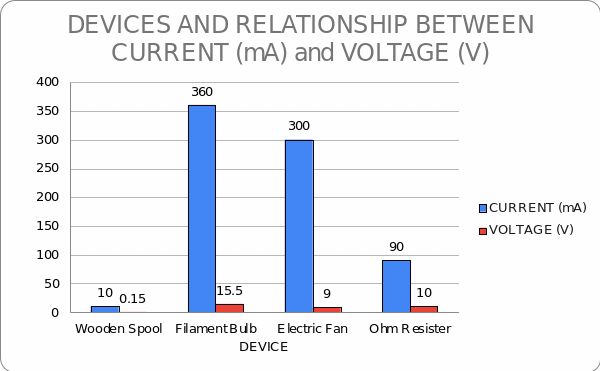The present work studies the relationship between the electric current applied to the body and the measured voltage using an experimental approach. It is known that current and voltage are related using Ohm’s law for direct current, so it was expected that the different resistances of the devices used would affect the measured voltage. In addition, it was interesting to investigate the correlation between voltage and current. The main findings of this paper were that the active resistance value was different for each of the devices used — Wooden Spool, Filament Bulb, Electric Fan, Ohm Resistor. In addition, the Pearson coefficient for current and voltage showed a strong positive relationship. Thus, the study fully confirmed Ohm’s law.
Introduction and Background
 (Khawaja, 2022). The present laboratory work investigates the relationship between voltages and currents within different bodies with expectedly different resistances. Two hypotheses are tested in the work: first, there are different active resistances for the different bodies used in the present experiment. Secondly, the more current was applied to the device, the more voltage was measured.
(Khawaja, 2022). The present laboratory work investigates the relationship between voltages and currents within different bodies with expectedly different resistances. Two hypotheses are tested in the work: first, there are different active resistances for the different bodies used in the present experiment. Secondly, the more current was applied to the device, the more voltage was measured.Method
The methodological basis of the experiment was based on the use of four different devices, through which a direct current of the measured strength was passed. For each of the four devices, the voltage value was also measured with a voltmeter, the ends were connected to the body with wires. The devices used included a Wooden Spool, Filament Bulb, Electric Fan, and Ohm Resistor. Since each of the bodies was a conductor, receiving zero voltages was not expected; however, the device would have been replaced by another if this had occurred. The primary data thus included a summary table of current values (in mA) and voltages (in V) for each of the four bodies (see Table 1). The data were then used for statistical analysis, which was to test the two previously given hypotheses.
Results
A summary table of the collected data is presented at the end of the work; the histogram shown in Fig. 1 was constructed from this table. The histogram shows the values of the applied currents and measured voltages for each of the four devices. In addition, the correlation was measured for the distribution of currents and voltages to determine the strength and direction of the relationship between the variables. The Pearson correlation coefficient was calculated using MS Excel as 0.817, indicating a strong positive relationship between applied currents and measured voltages. Finally, as part of the work, the values of all resistances according to Ohm’s law were calculated: the results are shown in Table 2.

Discussion
The present work aimed to investigate the relationship between voltages and currents using an experiment with four different devices. An applied current of varying strength was passed through the bodies of the devices and was expressed as a change in voltage, recorded with a voltmeter. In Figure 1, it was shown that the increase in applied current was precisely related to the increase in voltage, but the rate of this increase differed for each of the devices because of the different active resistance of the conductor. In addition, the Pearson coefficient demonstrated that as the current increases, the voltage increases invariably, indicating a strong positive relationship between the two variables. Thus, the results confirm the two initial hypotheses of this experiment and provide further proof of the practical application of Ohm’s law.
This experiment may have several limitations. First, the experimental sample of devices was not large enough, which may have affected the statistical reliability of the results – increasing the sample size solves this problem. Second, the current and voltage values may have been measured at different temperatures, which affected the resistance of the conductor – fixing the physical environment also solves this problem. A reasonable strategy is to measure the relationship between currents and voltages for AC rather than DC in future studies.
References
CK-12. (2019). 20.8 resistance. CK-12. Web.
Gregersen, E. (2020). Electric current. Britannica.
Khawaja, F. (2022). What is Ohm’s law and how do you calculate resistance equations? MUO.
Tables, Charts, and Figures
Table 1: Summary Table of Primary Data
Table 2: Calculation of Resistances for Each of the Sources